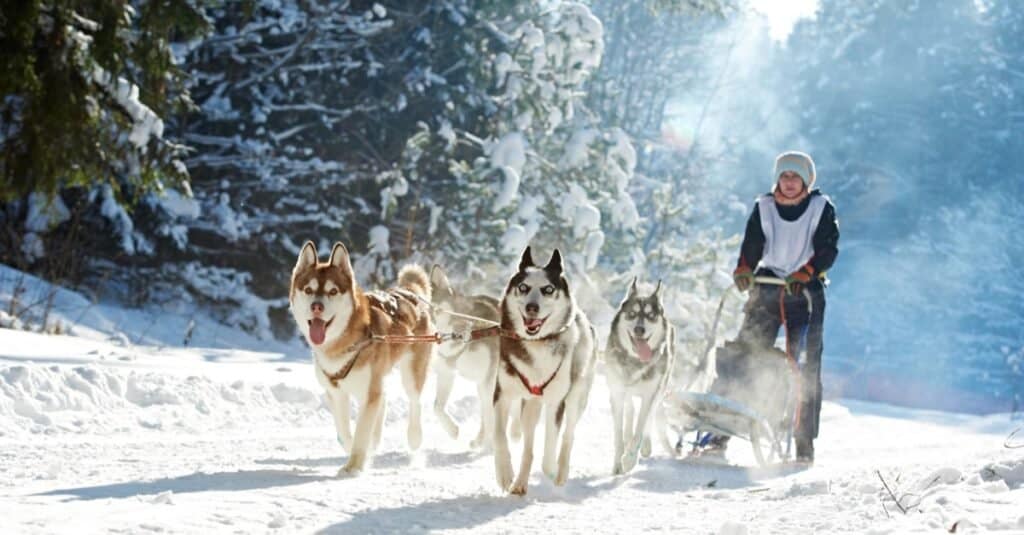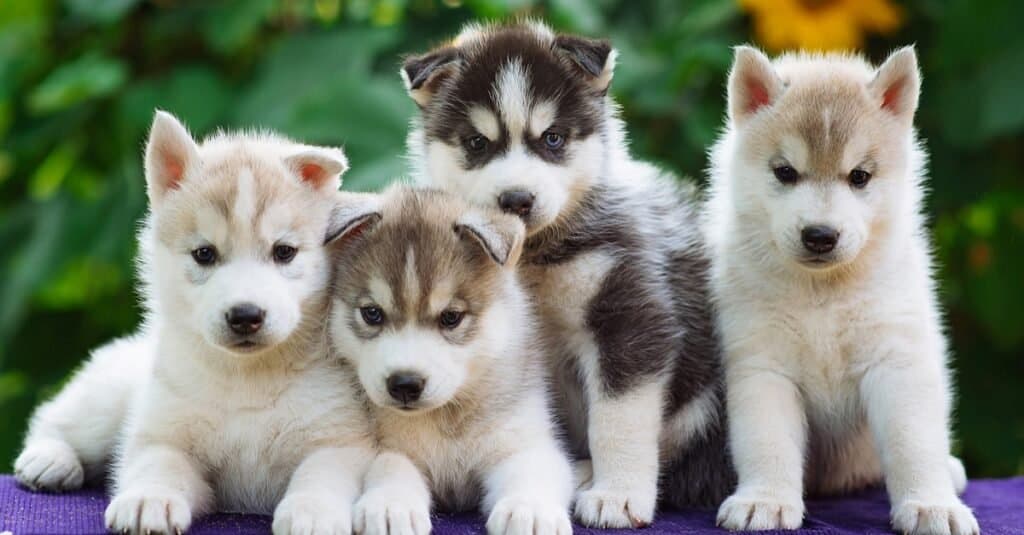The Siberian husky, a sled dog, was imported as a way to pursue to the Klondike Gold Rush. They have incredibly thick coats that allow them to withstand the briskly cold weather.
The husky – which primarily refers to the Siberian husky – is a lively and loyal animal. Their intelligence allows them to learn quickly, but only when they want to. Huskies have a boldly independent and free-spirited temperament. Though there are many facts to learn about taking proper care of a husky, you mostly just need a good yard and a family for these dogs to dote on.
See all of our expert product reviews.
Articoli correlati
- Guaritore del Texas
- Bunny vs Rabbit – 3 differenze principali
- Maiali selvatici nel Wisconsin: dove vivono e sono pericolosi?
- Scopri 6 incredibili animali dell'era paleozoica
- Jaguar vs Mountain Lion: chi vincerebbe in un combattimento?
Ever the friendly soul, Siberian huskies are easy to love and make into lifelong companions.
The 3 different types of Huskies and Husky mixes
When referring to the husky, the majority of people want to learn facts about the Siberian husky. However, enthusiasts of the breed recognize both the Alaskan husky and the miniature husky.
The Alaskan husky isn’t actually purebred. Instead, it shares some of the same genetics as the Siberian husky (which is why so many fun facts are shared between the breeds). The Alaskan husky is also a little bigger, weighing up to 60 pounds. The miniature husky looks just like a puppy, only standing 17 inches tall and reaching a maximum of 35 lbs. when it is an adult.
Owning a Husky: 3 pros and cons
Though there are many facts considered when choosing a dog, here are a few pros and cons to keep the balance of information.
| Pros! | Cons! |
|---|---|
| Friendly and loyal: The husky is truly meant to be a companion, bonding with its owner deeply. | Needs constant stimulation: Huskies hate being bored, so they’ll need to exercise and be entertained by their owner to avoid destructive behaviors. |
| Incredibly healthy: Though most dogs are prone to health conditions, the refined breeding of the husky makes it fairly healthy apart from a few hereditary conditions. | Strong-willed: As intelligent as the Siberian husky may be, all of the breeds like to do whatever they want. Training early may help. |
| Soft: You might have to brush them a little more often, but the coat of a husky is thick and beautiful. | Not suited for hot weather: If you live in a hot place like Florida or Arizona, the thick coat of the husky could make it difficult to do anything else. |

Dmitry Kalinovsky/Shutterstock.com
Health and Entertainment for your Husky
See all of our expert product reviews.
Husky Size and Weight
The size of the husky will depend on which of the breeds you want to learn about. The male Siberian husky, for example, reaches a size of 21-23.5 inches, weighing about 45-60 lbs. Females tend to be smaller in size at 20-22 inches and 35-50 lbs. Their coat colors tend to be white, black, and gray.
| Height (male) | 23.5 inches tall |
| Height (female) | 22 inches tall |
| Weight (male) | 45-60 lbs., fully grown |
| Weight (female) | 35-50 lbs., fully grown |
Husky Common Health Issues
One of the main issues that the Siberian husky faces are eye problems. Cataracts, corneal dystrophy, and even progressive retinal atrophy are all common issues that they may face. Most of the time, you can tell if they are prone to the condition as a result of their genetics. If you know the breeder of your puppy, it is best to learn as much as possible about the parents.
Another common risk for huskies is hip and elbow dysplasia. This condition causes the joints to be malformed, which can make simple acts like walking or even resting painful. With a lifespan of up to 15 years, always bring concerns for their body to their veterinarian.
Overall, huskies are fairly healthy animals. Still, the common health issues that huskies face include:
- Cataracts
- Corneal dystrophy
- Progressive retinal atrophy
- Hip dysplasia
- Elbow dysplasia
Husky Temperament and Behavior
One of the main reasons that people are attracted to the Siberian husky is their temperament. With a free-spirited personality, huskies tend to wander if they get bored. Even a few hours without physical activity are enough to lead to home or yard damage. After all, they have a bite force of 320 PSI. This bite force causes a lot of damage to many different materials. Huskies simply like to be engaged with their owner, bonding with them in an unbreakable way.
Among all of the dog breeds, huskies tend to have a certain level of loyalty to their family that other dogs don’t replicate. They prefer to be part of a pack, and that’s exactly how they see their family. They can be quite friendly with strangers, but they’ll sense any uneasiness that their owner has around someone. The strong-willed nature of huskies makes them difficult to train to be any other way, but it isn’t impossible. In fact, their intelligence is one of their most notable traits. Since they prefer to be with a “pack,” it is best to have a husky as a family dog (rather than a companion for a single person).
Though it is unlikely that a husky will become aggressive, take care to supervise interactions with younger family members. The bite force of a husky is strong enough to break bones, though they would have to be severely mistreated to warrant such an attack.
How to Take Care of a Husky
Taking care of a husky takes a little patience and a lot of consistency. It’s important for this dog to feel comfortable, but it shouldn’t feel so entitled that it walks all over other members of the family. Though the husky has a sweet temperament, there are many ways to make it feel at home and well cared for.
Husky Food and Diet
By the time that your husky is 16 weeks old, it should only need two meals in its diet of high-quality wet or dry dog food each day. It is best to maintain a consistent schedule, especially since it only takes these working dogs about 15-30 minutes before they need to go outside after a meal.
Puppy or not, the Siberian husky should not be allowed to freely graze on their food at any time. They may become bossy and could end up with weight issues that will need to be corrected with a restricted diet.
Husky Maintenance and Grooming
As big and beautiful as the Siberian husky is, this dog needs to have certain grooming to be healthy. They are clean by nature, grooming themselves to prevent odor. However, due to how thick their coat is, regular brushing is the best way to maintain their efforts. Brushing only needs to take place once a week, though you should check their ears and teeth during this care to eliminate buildup. When shedding season begins, you may need to switch to daily brushing to catch it all.
Take great care not to trim nails too short to avoid bleeding. Some pet owners choose to leave this responsibility to their vet or a groomer.
Husky Training
The Siberian husky can give its owner a run for their money when it comes to training. It isn’t so much that they can’t be trained; these dogs just prefer to use their intelligence in the way that they prefer. Many trainers encourage husky owners to keep their dogs off of their bed to assert dominance and to allow all members of the household to feed their pets to create a hierarchy.
With firmness, patience, and consistency, training a husky doesn’t need to be a chore. Socialization training is encouraged for this sled dog. They are friendly, but they also need to build confidence in a safe and controlled setting to promote positive interactions with humans and other dogs.
Husky Exercise
As both a sled dog and a working dog, huskies like to have many outlets for physical activity. Their body is built to engage in various types of exercise, and they can get bored without much to do. Since a bored puppy often leads to destruction, make sure to take this dog out on a walk or jog each day for no less than 30 minutes. However, spending at least most dogs prefer an hour.
If you aren’t giving them enough exercise, you’ll know soon enough – the Siberian husky loves to let out a loud howl when he is unhappy.
Husky Puppies

mary.foto.great/Shutterstock.com
Huskies grow rapidly, and their time spent as a puppy is crucial to raising a well-behaved and healthy animal. Puppies will eat up to three times daily until they are three months old, though they can be weaned down to two meals after this point. They should not have constant access to food, though it is important to stay hydrated.
Huskies and Children
The Siberian husky is an incredible family dog. Their patience with younger members of the household makes it easy to create a lasting friendship. They do not become aggressive easily, and they maintain a balanced temperament most of the time. Regardless of their training, always teach your children the best way to respect this working dog and supervise at all times.
These dogs often don’t get along with other dogs, so it is best if they are the only pet in the home. To eliminate this issue, socialization classes are very helpful.
Dogs similar to Huskies
If adopting a Siberian husky, Alaskan husky, or miniature husky isn’t the right match, there are other breeds to check out as well. Perhaps you should consider an Alaskan malamute, a Keeshond, or an Akita Inu.
- Alaskan Malamute: Often confused for a Siberian husky, the Alaskan malamute is slightly larger with a beautiful, curled tail. They are just as friendly, but they are also much quieter with the same black, white, and gray colors.
- Akita: The Akita has a beautiful white and orange coat. They are somewhat difficult to train, though they are fearless and intelligent.
- Keeshond: The Keeshond resembles more of a combination of a border collie and a husky, though they are just as fluffy and lovable.
Famous Huskies
Huskies have been around for quite some time, so it’s easy to find famous examples of them. Perhaps some of the most famous huskies are Balto, Togo, and Fritz, a group of three Siberian husky dogs that delivered antitoxin serum for diphtheria to children in Nome in the 1920s.
Mishka, the “talking” husky, is a little more well-known by the younger generation. She is featured on YouTube videos, making noises that resemble different phrases like “I love you.”
The popularity of the husky has even made its way into sports, like the University of Connecticut Huskies. Interestingly, the actual mascot isn’t a husky at all – it’s an Alaskan malamute!
Popular Names for Huskies
Some popular names for the husky include:
- Balto
- Togo
- Gus
- Diesel
- Jack
- Maya
pet store or backyard breeder is much less, only costing about $500 and $1,500. The lowest prices are found in animal shelters since the genetics of the dog don’t…
Categoria: Dogs


